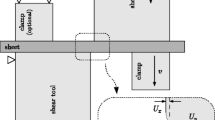Abstract
When a tensile stress is applied to a thin cracked plate, a strip necking region results ahead of a crack tip. The relative opening displacement between the crack surfaces and between the upper and lower boundaries of the strip necking region were measured by the moiré method. The strains ahead of the strip necking region and the thickness reduction (therein) were also measured. The measured relative opening displacements were compared with the calculated values using the Dugdale strip necking model. The thickness reduction in the strip necking region is equal to the relative opening displacement.
Similar content being viewed by others
References
Paris, P. C. andSih, G. C., “Stress Analysis of Cracks,” Fracture Toughness Testing and Its Applications, ASTM STP 381, 30–83 (1965).
Swedlow, J. L., Williams, M. L. andYang, W. H., “Elasto-Plastic Stress and Strains in Cracked Plates,”Proc. First Internatl. Conf. on Fracture, Sendai, Japan,1,259–282 (1965).
Drucker, D. C. andRice, J. R., “Plastic Deformation in Brittle and Ductile Fracture,”Engineering Fracture Mechanics,1,577–602 (1970).
Dugdale, D. S., “Yielding of Steel Sheets Containing Slits,”Jnl. of Mech. and Phys. of Solids,8,100–104 (1960).
Goodier, J. N. andField, F. A., “Plastic Energy Dissipation in Crack Propagation,”Fracture of Solids, Interscience, New York, 103–118 (1963).
Gross, B., Srawley, J. E. and Brown, Jr., W. F., “Stress Intensity Factors for a Single-Edge-Notch Tension Specimen by Boundary Collocation of a Stress Function,” NASA TN D-2395, (1964).
Gerberich, W. W., “Plastic Strains and Energy Density in Cracked Plates—Part I—Experimental Technique and Results,”Experimental Mechanics,4 (11),335–344 (Nov.1964).
Underwood, J. H. andKendall, D. P., “Measurement of Microscopic Plastic-strain Distributions in the Region of a Crack Tip,”Experimental Mechanics,9 (7),296–304 (July1969).
Liu, H. W., Gavigan, W. J. and Ke, J. S., “An Enghineering Analysis of Ductile Fractures,” Internatl. Jnl. of Fracture Mechanics,6 (1) (1970).
Brinson, H. F., “The Ductile Fracture of Polycarbonate,”Experimental Mechanics,10 (2),72–77 (Feb.1970).
Bilby, B. A., Cottrell, A. H. and Swinden, K. H., “The Spread of Plastic Yield from a Notch,” Proc. Royal Society,272,Series A (1963).
McClintock, F. A., “Discussion on Fracture Mode Transition for a Crack Traversing a Plate,”Trans. ASME, Jnl. of Basic Engrg.,82,423 (1960).
Liu, H. W., “Discussion on W. Weibull's Paper on the Effect of Size and Stress History on Fatigue Crack Initiation and Propagation,” Proc. of the Internatl. Symp. on Crack Propagation, Cranfield, England (1961).
Rosenfield, A. R., Dai, P. K. andHahn, G. T., “Crack Extension and Propagation Under Plane Stress,”Proc. First Internatl. Conf. on Fracture, Sendai, Japan,1,223–258 (1965).
Liu, H. W., “Fatigue Crack Propagation and the Stresses and Strains in the Vicinity of a Crack,” Applied Materials Research, (Oct. 1964).
Irwin, G. R., Kies, J. A. andSmith, H. L., “Fracture Strengths Relative to Onset and Arrest of Crack Propagation,”Proc. Am. Soc. Testing Materials,58,640 (1958).
Liu, H. W., “Yielding Initiation Process and Its Effect on Fracture of Cracked Plate,”Proc. First Internatl. Conf. on Fracture, Sendai, Japan,1,191–212 (1965).
Author information
Authors and Affiliations
Additional information
This report was produced under contracts sponsored by AISI and NASA. The conclusions and recommendations expressed are those of the authors and are not necessarily endorsed by the sponsor.
Rights and permissions
About this article
Cite this article
Schaeffer, B.J., Liu, H.W. & Ke, J.S. Deformation and the strip necking zone in a cracked steel sheet. Experimental Mechanics 11, 172–175 (1971). https://doi.org/10.1007/BF02324909
Issue Date:
DOI: https://doi.org/10.1007/BF02324909




